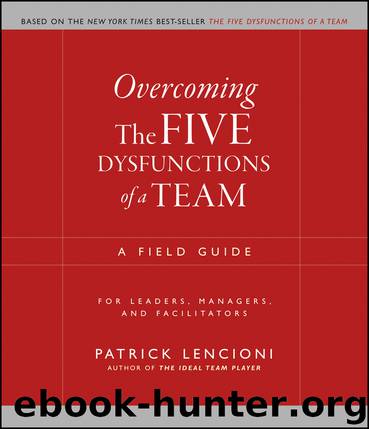Overcoming the Five Dysfunctions of a Team by Patrick M. Lencioni

Author:Patrick M. Lencioni
Language: eng
Format: epub
ISBN: 9780470893883
Publisher: Wiley
Published: 2005-05-06T02:47:42+00:00
FOCUSING ON RESULTS
Okay, if team members trust one another, engage in healthy conflict around issues, commit to the decisions they make, and hold one another accountable for those decisions, there is a pretty good chance they’re going to make it.
Unfortunately, when we build teams we rarely, if ever, go about it in a linear, chronological way. For instance, I don’t wait until my clients have completely addressed all of the first four dysfunctions before moving on to the fifth.
But even if we could, even if a team had overcome each dysfunction and seemed on the verge of the teamwork hall of fame (there isn’t one, by the way), there would still be a chance that it would stumble and lose sight of the ultimate measure of a great team: results. And that’s because your team is made up of extremely fallible human beings.
What is it about us that makes it so hard to stay focused on results? It’s this thing called self-interest. And self-preservation. We have a strong and natural tendency to look out for ourselves before others, even when those others are part of our families and our teams.
And once that tendency kicks in on a team, it can spread like a disease, quickly eroding the roots of teamwork until eventually even trust has been destroyed.
How do we avoid this? The key lies in keeping results in the forefront of people’s minds. There is a reason that old saying “out of sight, out of mind” is used so often: it’s true! A good way to focus attention is to use a visible scoreboard of some kind. Why a scoreboard?
Consider a football team. On a football field, a scoreboard focuses everyone’s efforts on one thing: winning. It doesn’t display defensive statistics or offensive statistics or individual player statistics. It provides unambiguous information about how the team is doing, and how much time the members have left if they want to improve the final outcome. That leaves little room for individual interpretation.
Imagine the quarterback of a team that is losing by fourteen points with three minutes to go in the game saying to the coach, “Well, I feel pretty good about things. I mean, my performance was not bad, and my stats look good.” The coach would be furious. He wants that quarterback, and everyone else on the team, to be focused on one thing: winning. And the only thing a team has to do to know whether it’s winning is to look at the scoreboard.
Teams within organizations need to do the same thing. They have to eliminate ambiguity and interpretation when it comes to success. It’s ironic that so many teams don’t do this, because they have an advantage over sports teams: they often get to create their own scoreboard! They decide what it is they want to achieve, and how they want to measure their success.
Certainly, many large and public companies don’t have the same kind of luxury, because they’re accountable for quarterly numbers and a stock price. But
Download
This site does not store any files on its server. We only index and link to content provided by other sites. Please contact the content providers to delete copyright contents if any and email us, we'll remove relevant links or contents immediately.
Hit Refresh by Satya Nadella(9039)
The Compound Effect by Darren Hardy(8810)
Change Your Questions, Change Your Life by Marilee Adams(7635)
Nudge - Improving Decisions about Health, Wealth, and Happiness by Thaler Sunstein(7615)
The Black Swan by Nassim Nicholas Taleb(7010)
Deep Work by Cal Newport(6880)
Daring Greatly by Brene Brown(6447)
Rich Dad Poor Dad by Robert T. Kiyosaki(6405)
Principles: Life and Work by Ray Dalio(6215)
Playing to Win_ How Strategy Really Works by A.G. Lafley & Roger L. Martin(5925)
Man-made Catastrophes and Risk Information Concealment by Dmitry Chernov & Didier Sornette(5921)
Digital Minimalism by Cal Newport;(5664)
Big Magic: Creative Living Beyond Fear by Elizabeth Gilbert(5614)
The Myth of the Strong Leader by Archie Brown(5425)
The Slight Edge by Jeff Olson(5346)
Discipline Equals Freedom by Jocko Willink(5285)
The Motivation Myth by Jeff Haden(5156)
Stone's Rules by Roger Stone(5026)
The Laws of Human Nature by Robert Greene(5000)
